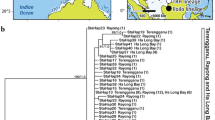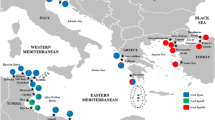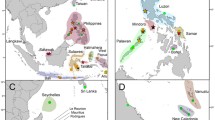Abstract
Colossendeis megalonyx Hoek, 1881 is a widespread and abundant pycnogonid in the Southern Ocean which has also been reported from the South Atlantic and South Pacific Oceans. Its strictly benthic lifestyle is expected to promote genetic differentiation among populations and ultimately facilitate speciation. On the other hand, the reported eurybathy and unknown larval stages of this species may allow Colossendeis megalonyx to maintain genetic continuity between isolated shallow-water habitats by active dispersal through the deep sea or by passive rafting on floating substrates. Thus, it remains unknown whether and to which extent geographically separated populations of Colossendeis megalonyx maintain gene flow in the Southern Ocean. We sampled 96 specimens of Colossendeis megalonyx from three stations in the Atlantic Sector of the Southern Ocean and one station from the South American continental shelf (Burdwood Bank). The genetic structure of nominal Colossendeis megalonyx as well as its phylogenetic position within the genus Colossendeis were assessed using a fragment of the cytochrome c oxidase subunit 1 gene. Our data strongly support that nominal Colossendeis megalonyx consists of at least five cryptic and one pseudocryptic mitochondrial lineages, four of which appear to be geographically restricted. Two lineages occurred at locations separated by more than 1,000 km in the Antarctic, thus indicating high levels of gene flow or recent colonization. No haplotype sharing across the Polar Frontal Zone was observed. Our results strongly suggest that cryptic speciation occurred within the genus Colossendeis. The wide biogeographic distribution range of Colossendeis megalonyx and perhaps that of other Antarctic pycnogonids should therefore be regarded with caution.



Similar content being viewed by others
References
Allcock AL, Brierley AS, Thorpe JP, Rodhouse PG (1997) Restricted gene flow and evolutionary divergence between geographically separated populations of the Antarctic octopus Paraledone turqueti. Mar Biol 129:97–102. doi:10.1007/s002270050150
Arnaud FBR (1987) The biology of Pycnogonida. Adv Mar Biol 24:1–96. doi:10.1016/S0065-2881(08)60073-5
Arntz WE, Brey T, Gallardo VA (1994) Antarctic zoobenthos. Oceanogr Mar Biol Annu Rev 32:241–304
Bain BA (2003) Larval types and a summary of postembryonic development within the pycnogonids. Invertebr Reprod Dev 43:193–222
Bamber RN, El Nagar A (2009) Pycnobase world pycnogonida database. http://www.marinespeciesorg/pycnobase. Accessed 15th Feb 2009
Barrett RDH, Hebert PDN (2005) Identifying spiders through DNA barcodes. Can J Zool 83:481–491. doi:10.1139/z05-024
Brandt A, Gooday AJ, Brandao SN, Brix S, Brokeland W, Cedhagen T, Choudhury M, Cornelius N, Danis B, De Mesel I, Diaz RJ, Gillan DC, Ebbe B, Howe JA, Janussen D, Kaiser S, Linse K, Malyutina M, Pawlowski J, Raupach M, Vanreusel A (2007) First insights into the biodiversity and biogeography of the Southern Ocean deep sea. Nature 447:307–311. doi:10.1038/nature05827
Cano E, Lopez-Gonzalez PJ (2007) Colossendeis species (Pycnogonida: Colossendeidae) collected during the Italica XIX cruise to Victoria Land (Antarctica), with remarks on some taxonomic characters of the ovigers. Sci Mar 71:661–681. doi:10.3989/scimar.2007.71n4661
Child CA (1995) Biology of the Antarctic Seas XXIV. In: Cairns SD (ed) Antarctic and Subantarctic Pycnogonida IV. The families Colossendeidae and Rhynchothoraxidae. American Geophysical Union, Washington
Child CA, Harbinson GR (1986) A parasitic association between a pycnogonid and a scyphomedusa in midwater. J Mar Biol Assoc UK 66:113–117. doi:10.1017/S0025315400039680
Clarke A, Crame JA (1992) The Southern Ocean benthic fauna and climate change: a historical perspective. Philos Trans R Soc Lond B Biol Sci 338:299–309. doi:10.1098/rstb.1992.0150
Clarke A, Johnston NM (2003) Antarctic marine benthic diversity. Oceanogr Mar Biol Annu Rev 41:47–114
Clarke A, Aronson RB, Crame JA, Gil JM, Blake DB (2004) Evolution and diversity of the benthic fauna of the Southern Ocean continental shelf. Antarct Sci 16:559–568. doi:10.1017/S0954102004002329
Clement M, Posada D, Crandall KA (2000) TCS: a computer program to estimate gene genealogies. Mol Ecol 9:1657–1659. doi:10.1046/j.1365-294x.2000.01020.x
Coyne JA, Orr HA (2004) Speciation. Sinauer Associates, Sunderland, MA
Crame JA (1997) An evolutionary framework for the polar regions. J Biogeogr 24:1–9. doi:10.1111/j.1365-2699.1997.tb00045.x
Edgar RC (2004) MUSCLE: multiple sequence alignment with high accuracy and high throughput. Nucleic Acids Res 32:1792–1797. doi:10.1093/nar/gkh340
Folmer O, Black M, Hoeh W, Lutz R, Vrijenhoek R (1994) DNA primers for amplification of mitochondrial cytochrome c oxidase subunit I from diverse metazoan invertebrates. Mol Mar Biol Biotechnol 3:294–299
Fry WG, Hedgpeth JW (1969) Pycnogonida, 1. Colossendeidae, Pycnogonidae, Endeidae, Ammotheidae. The Fauna of the Ross Sea, 7. NZ Oceanogr Inst Mem 49:1–139
Gutt J, Sirenko BI, Smirnov IS, Arntz WE (2004) How many macrozoobenthic species might inhabit the Antarctic shelf? Antarct Sci 16:11–16. doi:10.1017/S0954102004001750
Hanke M, Wink M (1994) Direct DNA sequencing of PCR-amplified vector inserts following enzymatic degradation of primer and dNTPs. Biotechniques 17:858–860
Hardin G (1960) The competitive exclusion principle. Science 131:1292–1297. doi:10.1126/science.131.3409.1292
Hart MW, Sunday J (2007) Things fall apart: biological species form unconnected parsimony networks. Biol Lett 3:509–512. doi:10.1098/rsbl.2007.0307
Hebert PD, Stoeckle MY, Zemlak TS, Francis CM (2004) Identification of birds through DNA barcodes. PLoS Biol 2:e312
Hedgpeth JW (1962) A bathypelagic pycnogonid. Deep-Sea Res 9:487–491
Hedgpeth JW (1964) Notes on the peculiar egg laying habit of an antarctic prosobranch (Mollusca: Gastropoda). Veliger 7:45–46
Hedgpeth JW (1969) Introduction to Antarctic zoogeography. In: Bushnell VC, Hedgpeth JW (eds) Distribution of selected groups of marine invertebrates in waters south of 35°S latitude. Antarctic Map Folio Series, Folio 11. American Geographical Society, New York, pp 26–28
Held C (2003) Molecular evidence for cryptic speciation within the widespread Antarctic crustacean Ceratoserolis trilobitoides (Crustacea, Isopoda). In: Huiskes AH, Gieses WW, Rozema J, Schorno RM, van der View SM, Wolff WJ (eds) Antarctic biology in a global context. Backhuys Publishers, Leiden, pp 135–139
Held C, Leese F (2007) The utility of fast evolving molecular markers for studying speciation in the Antarctic benthos. Polar Biol 30:513–521. doi:10.1007/s00300-006-0210-x
Held C, Wägele JW (2005) Cryptic speciation in the giant Antarctic isopod Glyptonotus antarcticus (Isopoda: Valvifera: Chaetiliidae). Sci Mar 69(Suppl 2):175–181. doi:10.3989/scimar.2005.69s2175
Helmuth B, Veit RR, Holberton R (1994) Long-distance dispersal of a subantarctic brooding bivalve (Gaimardia trapesina) by kelp-rafting. Mar Biol 120:421–426
Hofmann EE (1985) The large-scale horizontal structure of the Antarctic Circumpolar Current from FGGE drifters. J Geophys Res 90:7087–7097. doi:10.1029/JC090iC04p07087
Hoek PPC (1881) Report on the Pycnogonida dredged by H.M.S. Challenger, during the years 1873–1876. In: Thomson CW (ed) Report on the scientific results of the voyage of H.M.S Challenger during the years 1873–76. Zoology, vol 3. Neil and Company, Edinburgh, pp 1–167
Huelsenbeck JP, Ronquist F (2001) MRBAYES: Bayesian inference of phylogenetic trees. Bioinformatics 17:754–755. doi:10.1093/bioinformatics/17.8.754
Hunter RL, Halanych KM (2008) Evaluating connectivity in the brooding brittle star Astrotoma agassizii across the drake passage in the Southern Ocean. J Hered 99:137–148. doi:10.1093/jhered/esm119
Kattner G (1998) The expedition ANTARKTIS XIV/2 of RV “Polarstern” in 1996/97. Rep Polar Res 274:1–87
Knox GA (1994) The biology of the Southern Ocean. Antarct Sci 7:213–214
Leese F, Held C (2008) Identification and characterization of microsatellites from the Antarctic isopod Ceratoserolis trilobitoides—nuclear evidence for cryptic species. Conserv Genet 9:1369–1372. doi:10.1007/s10592-007-9491-z
Leese F, Agrawal SA, Held CH (2009) Long-distance dispersal of the brooding benthic isopod Septemserolis septemcarinata across major zoogeographic barriers in the Southern Ocean. Mar Biol (submitted). http://www-brs.ub.ruhr-uni-bochum.de/netahtml/HSS/Diss/LeeseFlorian/diss.pdf
Lehmann T, Gailer JP, Melzer RR, Schwabe E (2007) A scanning-electron microscopic study of Dickdellia labioflecta (Dell, 1990) (Gastropoda, Littorinoidea) on Colossendeis megalonyx megalonyx Fry and Hedgpeth, 1969 (Pycnogonida, Colossendeidae): a test for ectoparasitism. Polar Biol 30:243–248. doi:10.1007/s00300-006-0178-6
Linse K, Cope T, Lörz AN, Sands C (2007) Is the Scotia Sea a centre of Antarctic marine diversification? Some evidence of cryptic speciation in the circum-Antarctic bivalve Lissarca notorcadensis (Arcoidea: Philobryidae). Polar Biol 30:1059–1068. doi:10.1007/s00300-007-0265-3
Mahon AR, Arango CP, Halanych KM (2008) Genetic diversity of Nymphon (Arthropoda: Pycnogonida: Nymphonidae) along the Antarctic Peninsula with a focus on Nymphon australe Hodgson 1902. Mar Biol 155:315–323. doi:10.1007/s00227-008-1029-5
Munilla T (2001) Synopsis of the pycnogonids from Antarctic and Subantarctic waters. Polar Biol 24:941–945. doi:10.1007/s003000100305
Munilla T, Soler Membrives A (2008) Check-list of the pycnogonids from Antarctic and sub-Antarctic waters: zoogeographic implications. Antarct Sci 21:99–111. doi:10.1017/S095410200800151X
Nakamura K, Kano Y, Suzuki N, Namatame T, Kosaku A (2007) 18S rRNA phylogeny of sea spiders with emphasis on the position of Rhynchothoracidae. Mar Biol 153:213–223. doi:10.1007/s00227-007-0803-0
Nylander JAA (2004) MrModeltest v2.3. Program distributed by the author. Evolutionary Biology Centre, Uppsala University, Sweden
Page TJ, Linse K (2002) More evidence of speciation and dispersal across the Antarctic Polar Front through molecular systematics of Southern Ocean Limatula (Bivalvia: Limidae). Polar Biol 25:818–826
Pages F, Corbera J, Lindsay D (2007) Piggybacking pycnogonids and parasitic narcomedusae on Pandea rubra (Anthomedusae, Pandeidae). Plankton Benthos Res 2:83–90. doi:10.3800/pbr.2.83
Poulin E, Palma AT, Feral JP (2002) Evolutionary versus ecological success in Antarctic benthic invertebrates. Trends Ecol Evol 17:218–222. doi:10.1016/S0169-5347(02)02493-X
Pushkin AF (1993) The Pycnogonida fauna of the South Ocean (biological results of the Soviet Antarctic Expeditions). Russian Academy of Sciences -Rossiyskaw Akademiw Nauk, S Peterburg - Portoroza (Siciliw) Samperi Messina
Raupach MJ, Wägele JW (2006) Distinguishing cryptic species in Antarctic Asellota (Crustacea: Isopoda)—a preliminary study of mitochondrial DNA in Acanthaspidia drygalskii. Antarct Sci 18:191–198. doi:10.1017/S0954102006000228
Raupach MJ, Malyutina M, Brandt A, Wägele JW (2007) Molecular data reveal a highly diverse species flock within the munnoposid deep-sea isopod Betamorpha fusiformis (Barnard, 1920) (Crustacea: Isopoda: Asellota) in the Southern Ocean. Deep-Sea Res II Topical Stud Oceanogr 54:1820–1830. doi:10.1016/j.dsr2.2007.07.009
Raupach MJ, Mayer C, Malyutina M, Wägele JW (2009) Multiple origins of deep-sea Asellota (Crustacea: Isopoda) from shallow waters revealed by molecular data. Proc Biol Sci 276:799–808. doi:10.1098/rspb.2008.1063
Sirenko BI (2000) Symbiosis of an Antarctic gastropod and pantopod. Ruthenica 10:159–162
Swofford DL (2002) PAUP* Phylogenetic analysis using parsimony (*and other methods). Sinauer Associates, Sunderland, Massachusetts
Tamura K, Dudley J, Nei M, Kumar S (2007) MEGA4: Molecular Evolutionary Genetics Analysis (MEGA) software version 4.0. Mol Biol Evol 24:1596–1599. doi:10.1093/molbev/msm092
Thornhill DJ, Mahon AR, Norenburg JL, Halanych KM (2008) Open-ocean barriers to dispersal: a test case with the Antarctic Polar Front and the ribbon worm Parborlasia corrugatus (Nemertea: Lineidae). Mol Ecol 17:5104–5117. doi:10.1111/j.1365-294X.2008.03970.x
Villesen P (2007) FaBox: an online toolbox for fasta sequences. Mol Ecol Notes 7:965–968. doi:10.1111/j.1471-8286.2007.01821.x
Whitworth T, Nowlin WD, Worley SJ (1982) The net transport of the Antarctic circumpolar current through Drake Passage. J Phys Oceanogr 12:960–971. doi:10.1175/1520-0485(1982)012<0960:TNTOTA>2.0.CO;2
Wilcox TP, Hugg L, Zeh JA, Zeh DW (1997) Mitochondrial DNA sequencing reveals extreme genetic differentiation in a cryptic species complex of Neotropical Pseudoscorpions. Mol Phylogenet Evol 7:208–216. doi:10.1006/mpev.1996.0388
Wilson NG, Hunter RL, Lockhart SJ, Halanych KM (2007) Multiple lineages and absence of panmixia in the “circumpolar” crinoid Promachocrinus kerguelensis from the Atlantic sector of Antarctica. Mar Biol 152:895–904. doi:10.1007/s00227-007-0742-9
Wilson NG, Schrödl M, Halanych KM (2009) Ocean barriers and glaciation: evidence for explosive radiation of mitochondrial lineages in the Antarctic sea slug Doris kerguelenensis (Mollusca, Nudibranchia). Mol Ecol 18:965–984. doi:10.1111/j.1365-294X.2008.04071.x
Acknowledgments
We would like to thank Franz Krapp for his help with the determination of specimens and for helpful comments on this manuscript. Hieronymus Dastych kindly provided valuable reference specimens. Claudia Arango provided us with helpful information on the biology of colossendeids. This work was supported by a grant of the Ruhr-University of Bochum (Rektoratsfonds) to FL and CM, and a NSF grant OPP-0132032 to H.W. Detrich III. This is publication number 24 from the ICEFISH Cruise of 2004.
Author information
Authors and Affiliations
Corresponding author
Additional information
Kathrin Krabbe, Florian Leese contributed equally to this study.
An erratum to this article can be found at http://dx.doi.org/10.1007/s00300-010-0777-0
Rights and permissions
About this article
Cite this article
Krabbe, K., Leese, F., Mayer, C. et al. Cryptic mitochondrial lineages in the widespread pycnogonid Colossendeis megalonyx Hoek, 1881 from Antarctic and Subantarctic waters. Polar Biol 33, 281–292 (2010). https://doi.org/10.1007/s00300-009-0703-5
Received:
Revised:
Accepted:
Published:
Issue Date:
DOI: https://doi.org/10.1007/s00300-009-0703-5




